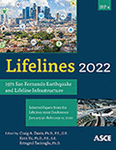Seismic Resilience in Design of New Water Supply Systems: A Natural Disaster Resilience Framework Informed by Lessons Learned from the 2011 Tohoku Earthquake and Tsunami Crisis
Publication: Lifelines 2022
ABSTRACT
To prepare for future seismic events, effective resilience frameworks informed by lessons from past disasters will help to address this complex problem. This work discusses a seismic resilience design approach for a new water infrastructure system supported by an effective framework and lessons learned from the 2011 Tohoku earthquake and tsunami crisis. This work discusses four main topic areas including describing the $1.3 billion Willamette Water Supply System (WWSS) and the seismic hazard it faces. It discusses key insight drawn from the 2011 Tohoku earthquake and tsunami crisis in Japan. From this an overall resilience framework that addresses the complexities and interconnected elements associated with natural disasters is proposed. Finally, the resilience framework, together with the lessons learned from the Tohoku earthquake and tsunamic crisis and other related thinking are applied to the WWSS to illustrate how the framework can be practically and effectively implemented to improve the resilience of water infrastructure systems. This work provides a case study of how these measures can be implemented in the development of a new seismically resilient water infrastructure system, as well as highlights fundamental policy decisions related to establishing level of service priorities.
Get full access to this article
View all available purchase options and get full access to this chapter.
REFERENCES
Blackman, D., Nakanishi, H., and Benson, A. M. (2017). Disaster resilience as a complex problem: Why linearity is not applicable for long-term recovery. Technological Forecasting and Social Change, 121, 89-98.
Britch, M., Havekost, M., and Robless, B. (2020, June 10). Seismic Guidelines and Minimum Design Requirements. Willamette Water Supply Program. Version 1.1.
Britch, M. (2019, July 21). Natural Disaster Resiliency Framework and Leadership Examples from Japan (Unpublished term paper). ; Tokyo, Japan. Portland State University.
Britch, M. (2018). Seismic Guidelines for Ductile Iron Pipe. In Ductile-Iron Pipe and Fittings (M41): AWWA Manual of Water Supply Practice. AWWA. Draft (not published).
Britch, M. (2015). TVWD’s Emergency Preparedness Framework (Unpublished capstone paper). Portland State University.
DHS (US Department of Homeland Security). (2016). National disaster recovery framework. 2nd Edition.
Duyck, A. (2013, May 15). TVWD Board Meeting. Beaverton, OR. Public Testimony.
FEMA. (2014, April). Cascadia subduction zone earthquakes: A magnitude 9.0 earthquake scenario. Emergency Management Institute Community-specific integrated emergency management course, Emmitsburg, MD.
FEMA. (2012, December). FEMA E-74 Reducing the Risks of Nonstructural Earthquake Damage – A Practical Guide. US Department of Homeland Security.
Ito, H. (2019, April 27). Pre-trip Session#1 [Class PowerPoint and notes]. Portland State University Professor of Economics.
Meyersohn, N. (2017, September 11). The costliest natural disasters in U.S. history. Retrieved June 2, 2019, from https://money.cnn.com/2017/09/11/news/costliest-natural-disasters/index.html.
Minami-Gamo. (2019, June 23). Minami Gamo Neighborhood Association members [Lecture presentation, Sendai, Japan].
Karamanos, S. A., Sarvanis, G. C., Keil, B. D., and Card, R. J. (2017). “Analysis and Design of Buried Steel Water Pipelines in Seismic Areas.” ASCE Journal of Pipeline System Engineering Practice, 04017018-1 -0417018-11. doi:https://doi.org/10.1061/(ASCE)PS.1949-1204.0000280.
NIST. (2018). US Department of Commerce, National Institute of Standards and Technology. Research Needs to Support Immediate Occupancy Building Performance Objective Following Natural Hazard Events.
NIST. (2015). US Department of Commerce, National Institute of Standards and Technology. Community Resilience Planning Guide for Buildings and Infrastructure Systems (Special Publication 1190-1).
OSSPAC (Oregon Seismic Safety Policy Advisory Commission). (2013). The Oregon Resilience Plan: Reducing Risk and Improving Recovery for the Next Cascadia Earthquake and Tsunami, Salem, OR, February, http://www.oregon.gov/OMD/OEM/osspac/docs/Oregon_Resilience_Plan_Final.pdf.
PPD-21 (Presidential Policy Directive). (2013). The White House, February 12, 2013, http://www.whitehouse.gov/the-press-office/2013/02/12/presidential-policy-directive-criticalinfrastructure-security-and-resil.
Ranghieri, F., and Ishiwatari, M. (2014). Learning from Megadisasters: Lessons from the Great East Japan Earthquake. World Bank Publications.
Ripley, A. (2009). The Unthinkable Who Survives when Disaster Strikes - and Why. New York, NY: Three Rivers Pr.
Sato, K. (2019, June 26). Kesennuma City Memorial Museum [Lecture presentation]. Museum Director.
The Japan Times. (2011). 3.11 – A chronicle of events following the Great East Japan Earthquake.
Information & Authors
Information
Published In
History
Published online: Nov 16, 2022
Authors
Metrics & Citations
Metrics
Citations
Download citation
If you have the appropriate software installed, you can download article citation data to the citation manager of your choice. Simply select your manager software from the list below and click Download.
